Because the next ten years were to bring National honours to club members in time trials and on the track, and to both men and women, it has proved preferable to record the disciplines separately.
There was a mood of optimism by 1947 and people could begin to look forward to the future. Even though there were still hardships in everyday life there was much more freedom for leisure activities and one of the most easily available was cycling. Television was still in its early stages of development and few owned a set, so cinema going was still a popular pastime. In and around Croydon there were fourteen cinemas operating and some chose to include roller racing as part of their entertainment. Few families had yet aspired to owning a vehicle and those that did were at first restricted by petrol rationing. As during the period of the war, the bicycle was an excellent means of moving about. Whereas during the war restrictions had been imposed on traffic movement, including the bicycle, these soon eased, as did the ability to tour in Europe. All this brought more people into cycling club life.
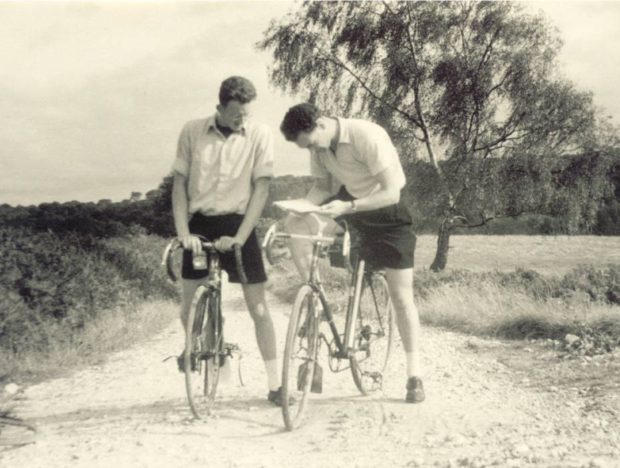
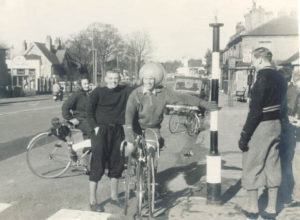
The Olympic Games coming to London in 1948 already aroused much excitement. The cycling track events were to be staged at Herne Hill and the road race in Windsor Great Park. Preparations were very basic as compared with later Games.
Norman Cox was invited to ride at the 1947 Southern Counties Good Friday meeting, and with a star-studded field that included riders from overseas this was indeed an invitation not to be turned down. Both he, Don Hunnisett, Bob Eatwell, Alan Stuart, Anne Hunnisett (Don’s sister), Ray Cooke and Pat Cooke were performing well on the track and this encouraged others.
In massed start and ‘rough stuff’ events Don Stone had proved himself a formidable rider and the club was sorry to lose his membership to the ’34 Nomads as he later progressed to take a National title. His younger brother Norman was making promising progress before he too changed clubs, a familiar story within cycling clubs that still occurs, you lose some, you gain some. One gain, fifty-five years on, was Norman’s son Neil. He eHe rode well and took on official duties with the club looking after the roller racing.
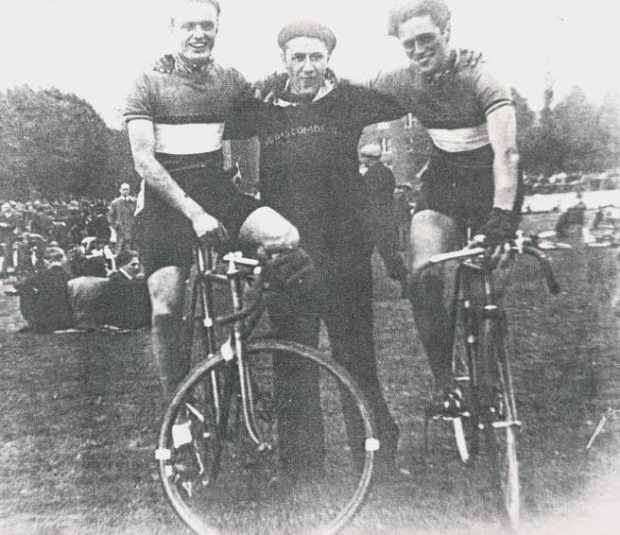
The first club run of each new year was traditionally to the coast and back, Eastbourne or Hastings being the favoured destinations, followed by Reliability Trials (promoted by other clubs) being run over 100 miles with riders able to qualify for, say, 100 miles in 6, 7 or 8 hours. One typical event organised by the Southern Elite C.C. started on Mitcham Common, moved out by a hilly route into Kent, across to Horsham before finishing at the top of Reigate Hill. Fourteen members entered the Southern Elite’s Trial in 1948 with 9 qualifying, including 2 girls. Meanwhile, Charlie Davey, with his background of racing and record breaking was encouraging members to greater things. A Racing Fund was inaugurated, its purpose being to give financial assistance to these riders. (The Fund was finally closed down in the early 1990’s).
As stated, few families owned vehicles in the years immediately after the war but the Addiscombe were lucky to have Frank Deacon as a member. Frank ran an RAC recovery business at Hove and had a 5 cwt Bradford van (pictured). Careful packing, and with the rear doors wedged open with a steel bar, it was possible to get four riders and four bicycles in and over the next ten or so years Frank conveyed teams (Trade vehicle – maximum speed 30 mph) as far afield as Yorkshire and Cheshire.
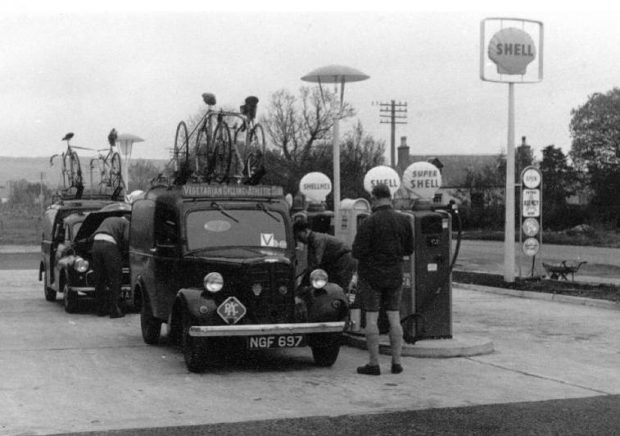
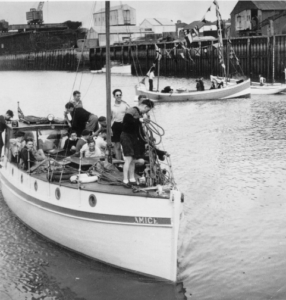
Frank Deacon’s home was on a boat moored in Shoreham harbour and he was responsible for arranging several sea excursions to Littlehampton and back. For years Frank also provided a superb annual picnic, with an ample supply of food and beverage at a chosen pleasant location. Another vehicle owner to lend support was Vic Ware, his Morris van is parked behind Frank Deacon’s above. If three travelled on the front bench seat Vic said he always sat his wife Edna next to the passenger door as he alleged, it had a habit of flying open! Both he and Edna were great characters and full of humour. Harvey Smith casts off as Frank steers for the sea.
Numerous trophies have been donated and re-donated to the club over the years but one that deserves mention was presented by Ron Davey, originally called “The Addiscombe Cup” and won by his father Ted Davey (elder brother of Charlie) in 1904.
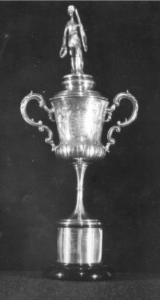
When presented to the club in 1948 (pictured) the trophy was renamed the Ted Davey Cup to be awarded for the best aggregate 10 and 25 miles by a lady member. Sadly, the trophy’s antiquity was rather destroyed when an official decided the lid was no longer necessary. Proposals had been ongoing in the area for several years for the formation of a Croydon Stadium, the most likely site being Duppas Hill. By 1948 the idea was ‘eventually turned down for now’ and 58 years later with this situation unchanged other local grass tracks too have long since disappeared also the future of the one remaining hard track at Herne Hill hangs in the balance.
As in the pre-war years, touring was a great part of club life whether in large or small groups. Annual holidays were invariably of no more than two weeks duration, so Easter and Bank Holiday weekends were eagerly anticipated as another opportunity to get away awheel. Sometimes touring was mixed with a more distantly placed time-trial, as in the year a group went to South Wales, the Armstrongs to ride a tricycle race and the girls a “25”. Foreign travel did not recover from the war years until the early 1950’s and being based relatively close to the Channel ports it was then not long before small groups were exploring France, Spain, Switzerland, Austria, Italy and Norway.
It is not possible to detail all the Annual Dinners but the photograph of the 1948 gathering at the Café Royal, North End, is typical of many occasions. The chief guest was W. J. “Bill” Bailey, four times World Amateur Sprint Champion between 1909 and 1913 and a regular competitor at Herne Hill both as an amateur and professional.
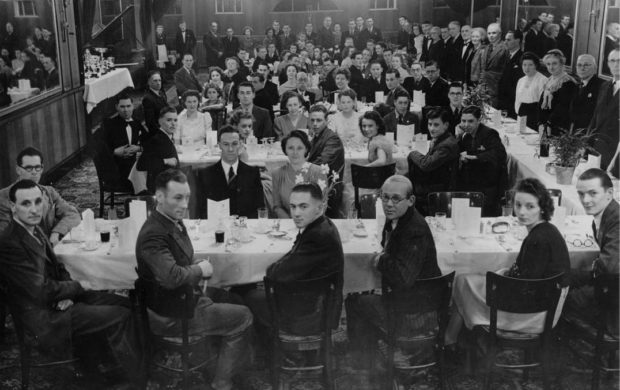
The majority of members still opted for time trialling as their chosen discipline. It fitted in well with traditional club life and touring and did not necessarily call for any extra equipment. Charlie Davey announced he would stand down as President at the end of 1950 and Percy Huggett was nominated as his successor. At that time a decision was taken that the office of President should remain with one person for not more than three years as it was felt there were a number of members who should be so honoured. As had always been the case, the committee continued to ensure they were represented at the AGM’s of the Associations to which they affiliated and in many cases members took on duties as officers or committee members. It was recognised this was the only way the Associations could continue and if members wanted to ride in the events, they promoted then the club had to give its full support.
To celebrate the club’s 21st birthday a brief history of the club was produced. 164 diners attended the “Coming of Age” dinner on 28th January 1950 at the Café Royal, North End, Croydon. The charge was the princely sum of 13/6d per head (67.5 pence). W. F. “Sandy” Holdsworth of the South East London cycle company proposed the toast to the club and members presented Charlie Davey with an illuminated address in recognition of his enormous contribution to the club and his 21 years as President. For probably the first time in his life Charlie, a first-class Chairman, was too overcome to respond and his proposed reply was later printed in The Gazette. A change of magazine editor had also become necessary on the resignation of Ron Davey. Since its inception the magazine had appeared as duplicated foolscap sheets.
When Stan Roach took the job on in 1950 although the paper remained the same size he produced The Gazette in booklet form on a long-carriage typewriter. Chris Watts and Ron Pitt recall their periods as editor, the difficulty in manipulating the stencils lengthways into the long-carriage typewriter, not to mention the various duplicating machines used as their design improved. For a short period a two-colour magazine appeared although changing the drum on the duplicator was always a messy job. Another person who carried on the editorship for many years was Jessie Nicholls. She and her husband George had originally been members of the Dale Park Club that had folded during the 1940’s. They both gave immense support to the Addiscombe and George Nicholls, a keen photographer, was always on the lookout for a good photo.
Membership was rising and in early 1950 stood at 93 seniors, 22 juniors, 7 Forces, 10 senior ladies, 2 junior ladies, 17 associates and 10 Life members, a grand total of 161. To cater for the large membership the club moved their weekly meetings to St Matthew’s Hall, Cross Road, with clubroom stewards Joyce Smith and Bob Halfacre. The tiny pub “The Fox Under the Hill”, sited under Windmill Bridge just round the corner, received regular custom from those looking for something stronger than tea.
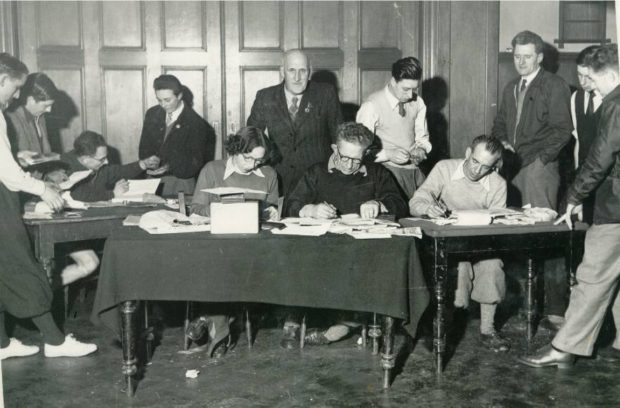
Frank Deacon’s club picnic was usually well recorded in The Gazette. On 14th May 1950 those riding the Club 30 had to reach Pease Pottage for a 7.30 am start. The scribe, Phil Lewis, was also timekeeper of the “30” and he reports all entrants (8 solos, 1 trike and 2 tandems) started and finished. Breakfast at County Oak also became elevenses for the club run that departed from the Astoria Cinema, Purley at 9 am. A steady ride via Horsham and the A24 to Worthing for “a sumptuous lunch” followed. Members then proceeded along to Goring to meet up with Frank Deacon “and his catering staff” for a picnic tea consisting of ham, salads, bread, jam, tea, etc. “more than could be eaten despite the efforts of John Smith”. The ride home was against the wind and all went steadily until the Crawley by-pass when Charlie Davey started “a tear-up” for which he was afterwards admonished by the Club Captain who said, “he set a bad example to others nearly all of whom were young enough to be his grandchildren”. More refreshment was then taken at County Oak and it is unrecorded what time they eventually rolled into Addiscombe.
The committee decided to promote an Open 50 for Men in 1950 and Charlie Davey presented the club with one of his own silver trophies as an annual award. The event was won by Vin Callanan, Norwood Paragon C.C. in 2.10.40 with John Smith in second place in 2.10.50. The event was held annually up to 1982.
Those gathered at the 1951 Dinner enjoyed the company of the current National Best All-Rounder, Ken Joy, Medway Wheelers, with his future wife, Janet Gregory, the 1949 Women’s 50 miles Champion. Perhaps inspired, the year proved a good one for the men in the 24 hours Championship with Gus Andrews 24 Hours Champion and the following year, 1952, was even better with Eddie Mundy 24 Hours Champion and Daphne Stratford taking bronze medal in the Women’s 100 Championship. With the added bonus of Addiscombe riders taking the 24 Hours Team both years it follows that the presentations to the medal winners at the Royal Albert Hall were well supported. Ken Joy took the National BBAR again both years to make four in a row.
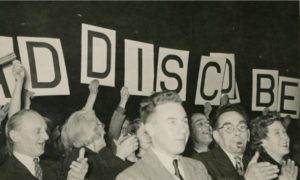
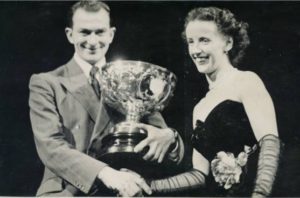
Other competition between cycling clubs included “walks” and “runs”. The Jim Wood Memorial Walk held to the north of London was in its seventh year when A. W. T. Banning, a young member, finished fastest junior and in 1951 Banning finished 16th among the seniors with Clive Howe 4th junior. Daphne Stratford and Eileen Cullen also stepped out. Ron Pitt (pictured) entered the Belle Vue Run on Epsom Downs but just laughs when asked “where were the other competitors?” Was he out in front or the last man? We can only guess. Quite a few members participated annually in this event though results went unrecorded. Other off-season competitions have always been the speed- judging and free-wheel contests. The latter were easier to control when everyone rode a fixed wheel and it was simply a case of removing the chain for the competition!
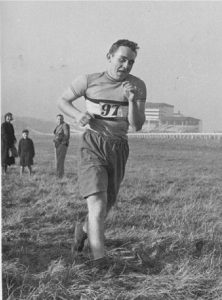
Another “institution” was the Christmas Day morning run to Mrs Curds, a popular café on Godstone Green. Following the consumption of elevenses, the run then proceeded to Merstham to join with other clubs at The Jolliffe Arms for “light refreshment”. Luckily other traffic was almost non-existent for the mass tear-up back to Croydon to join one’s family for Christmas lunch.
1953 was not the best year for Daphne Stratford who suffered quite severe facial injury when knocked off her bike by a dog running into her wheel. Eileen Cullen and Betty Perry also had their spills due to a female motorcyclist and the dreaded tramlines that had not yet been removed. Everyone was pleased when the girls bounced back to fitness.
With so many single females having joined the Addiscombe it is not surprising that a speaker at the Annual Dinner named the club as a matrimonial agency. 1954 had seen the weddings of ten members – Chris Brooker and John Watts, Daphne Stratford and Alan Grist, Joyce Wawman and John (“JB”} Smith, Sally Sapp and Ron Drake, Doris Kerry and Ron Tibbetts, with the customary archway of wheels as the happy couples left the church.
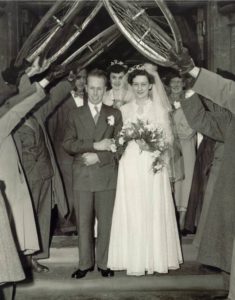
Following this “matrimonial year” the girls’ successes awheel would gradually give way to pushing wheels as the offspring started to arrive. The year was, weddings aside, to turn out Addiscombe’s best year by men and women for its haul of RTTC medallions. A large contingent of members and family once again attended the Royal Albert Hall to witness Frenchman Louison Bobet, following his second consecutive victory in the Tour de France, present the awards to our team champions. Cyril Hinton made a huge banner to take to the presentation. The club became indebted to Hinton over the years for his artwork and for, amongst other things, the excellent result boards he produced for the Open events.
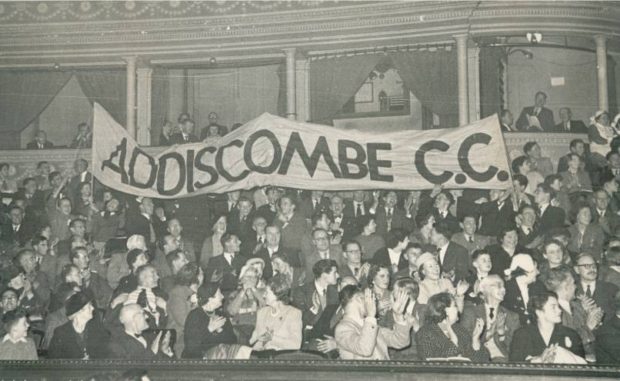
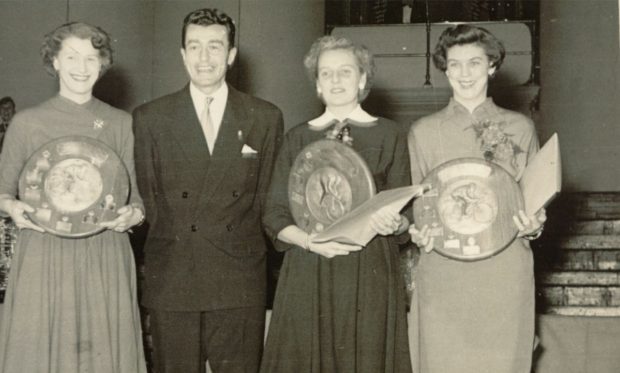
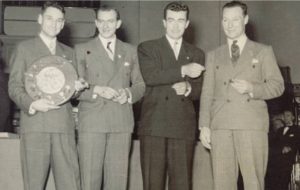
Summing up 1954, the year’s tally of time trial successes was twenty-eight team wins (fifteen of these to the women including two National Championships, and the National Best All-Rounder Team, plus a National Competition Record). Twelve Open solo wins were scored (6 to the men and 6 to the women, plus a National Competition Record), fourteen 2nd placings (8 men and 6 women), four 3rd placings (3 men, 1 woman) and five 1st Handicaps (3 men, 2 women). The majority of these successes are detailed in the following pages.
Rand joined a party from “Cycling” to see the finish of the Tour de France in 1955. This was before the Tour finished on the Champs-Elysees. In “The Gazette” he recorded his experience: “At the stadium entrance part of my ticket was torn off by a bowler-hatted Frenchman!… … the seating capacity is enormous with room for 60,000 spectators, the actual track however is smaller than Herne Hill but has much steeper bankings… …every event was run off without a time lag in between. During the racing up-to-the-minute reports were given over the loudspeakers of the Tour position. In the sprint event both Harris and Peacock were soon eliminated, but it wasn’t through lack of encouragement from the British contingent. In the omnium between Coppi and Koblet v. Anquetil and La Bere, Coppi was outstanding, especially behind Vespas. He seemed to be very popular with the crowd. Suddenly everything was hushed as an announcement was made that the Tour was within four hundred yards of the Velodrome, and when the first rider, Poblet, entered the place went crazy, with everyone jumping up and down on their seats and cheering and waving excitedly. When Robinson and Hoar entered, yours truly went berserk also. It was stirring to hear and see 60,000 people cheering for cyclists and the memory will remain with me for a long while. While Bobet had a rub down, donned a new jersey and combed his hair, the photographers were practically climbing over each other, trying to get pictures. To finish off the meeting the top ten riders rode a lap of honour, and then followed the teams headed by their respective managers. The last pair to circle the track were Robinson and Hoar to a tremendous reception.”
Apart from the war years the club dinner had always been held at the Café Royal, North End. Closure of the establishment for site redevelopment meant a new venue and in January 1956 the club moved to the Zeeta Restaurant in George Street where they remained until 1960.
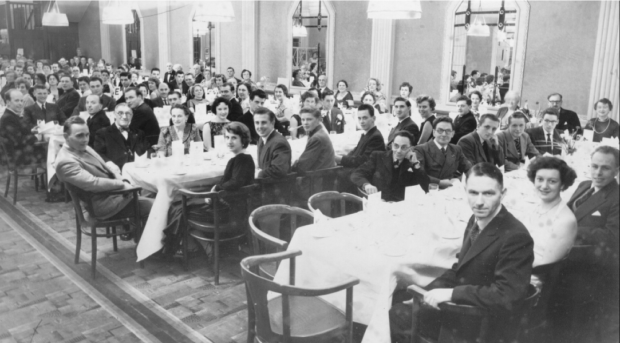
It was during the mid-1950’s that the battle over road racing developed between the National Cyclists’ Union and British League of Racing Cyclists. With our members seeking their own solution, though probably strictly against the dictates from these Bodies, this period of Addiscombe history has deserved its own section.
- An Introduction to our History
- The 1883 Addiscombe Cycling Club
- The 1906 Addiscombe Cycling Club
- An Historical Background to the Road Record Associations
- A Brief Historical Background to Cycling Time Trials
- The Club’s Revival, 1929 to 1939
- The Club in Wartime, 1940 to 1946
- The Post-War Years, 1947 to 1957
- Post-War Track and Roller Racing
- The Men in Post-War Time Trials
- The Women in Post-War Time Trials
- Post-War Closed Circuit and Road Racing
- An Influx of New Riders and the Passing of a Statesman, 1958 to 1964
- The Club Heads Towards its Golden Jubilee, 1965 to 1978
- Membership Declines, 1979 to 1987
- The Arrival of the Young Mountain Bikers, 1988 to 1994
- Another Period of Declining Membership, 1995 to 1999
- New Century and a New Look for the Addiscombe, 2000 to 2006





